Occupational environment monitoring in a mine
99,000 ₫
Note: The above price is calculated for one sample, and the price may fluctuate depending on the area of the environment to be monitored and market movements. For more accurate pricing support, please refer to the price list or contact our consulting staff directly.
Monitoring the environment of mines is a session of collecting, analyzing, and evaluating factors at the workplace that may harm workers health.
Table of Contents
Toggle1. Overview of Mines
a. What is a mine?
A mine is an underground structure created to extract mineral resources from the earth. It is an underground space providing access to mining areas, where workers and mining equipment can reach and operate.
Mines can vary in size and shape depending on the type of resource being extracted and the mining method used. They can be dug as cross-section tunnels or long cylindrical shafts. Mines are usually constructed using tunneling methods, employing machinery and technology to create a network of interconnected tunnels.
Mines play an important role in the mining process because they provide a safe and convenient transportation system for moving workers, transporting resources, and handling mining equipment. They also provide a protective space to cope with environmental factors such as high temperatures, humidity, pressure, and hazardous gases.
Mines are typically equipped with safety devices such as lighting systems, ventilation systems, emergency exits, and fire and explosion control systems to ensure a safe working environment for workers.

b. Jobs inside the mine
Jobs inside the mine for workers may include:
- Tunneling and soil excavation: Workers perform tunneling and soil excavation using tools and machinery such as excavators and soil diggers to create space for further resource extraction and transportation.
- Mineral extraction: Workers extract mineral resources from underground. This may include blasting, mining, and using mining machinery to collect and transport resources.
- Equipment inspection and maintenance: Workers inspect, maintain, and repair equipment and machinery in the mine to ensure safe and efficient operations.
- Installation of support systems: Workers may participate in installing support systems such as ventilation, drainage, electrical systems, and other safety systems to ensure a safe and convenient working environment.
- Management and supervision: Workers may take part in managing and supervising activities within the mine, including monitoring extraction processes, ensuring compliance with safety and environmental regulations, and reporting production performance and incidents if any.
Work in mines requires careful attention and adherence to safety and environmental protection regulations, so workers need proper training and the necessary skills and knowledge to perform tasks safely and effectively.

c. Types of machinery used in mines
Various types of machinery are used in mines to perform extraction and transportation tasks. Some common types include:
- Excavators: Used for digging, moving soil, and handling materials. Excavators come in different types such as backhoe loaders, tracked excavators, and wheeled excavators depending on mining conditions.
- Drilling machines: Used to drill holes in rock and soil to prepare for mining. Types include handheld drills, surface drills, rock drills, pneumatic drills, geological drills, and terrain drills.
- Crushers and cone crushers: Used to crush mineral resources into smaller particles for easier transportation and processing.
- Dredgers and cutters: Used to collect samples and cut soil and rock during extraction.
- Transport machines: Including loaders, bulldozers, tractors, mixers, and other transportation machinery to move materials from inside the mine or to other areas.
- Loaders: Used to scoop, move, and dump materials during mining operations.
- Air compressors: Provide compressed air to operate tools and equipment in the mine, including drills, jackhammers, and dredgers.
- Safety equipment: In mines, safety devices such as flashlights, gas masks, reflective clothing, and warning systems are used to ensure worker safety in hazardous environments.

d. Occupational diseases for mine workers
Workers in mines may face several occupational diseases, including:
- Lung diseases: Mine workers are at risk of inhaling mine dust, including rock dust, mineral dust, and coal dust, which can cause lung diseases such as silicosis, pneumoconiosis, and other respiratory problems.
- Accidents and injuries: The mining environment carries a high risk of accidents, including mine collapses, collisions, falls from heights, explosions, and other hazards. These incidents can result in serious injuries, including fractures, head injuries, and spinal injuries.
- Musculoskeletal disorders: Mining work involves physical activity, lifting heavy objects, and working in challenging environments, leading to musculoskeletal strain, back pain, joint degeneration, and spinal issues.
- Cardiovascular diseases: Workers often face challenging environments, time pressure, and work stress, increasing the risk of cardiovascular diseases such as coronary artery disease, hypertension, and heart attacks.
- Skin diseases: Exposure to chemicals, oils, and solutions during mining can cause skin conditions such as dermatitis, allergic reactions, psoriasis, and eczema.
- Heat-related illnesses: Some mines have high or fluctuating temperatures, posing risks of heatstroke, heat shock, or dehydration.

e. Types of products in mines
Mines may produce and extract various products depending on the resources being mined. Some common products include:
- Coal: Coal mines extract coal for industrial and energy use. Coal is used for electricity generation, steel production, fuel, and other industrial processes.
- Metallic minerals: Mines provide precious and base metals such as gold, silver, copper, zinc, lead, aluminum, nickel, tin, and titanium. These metals are used in manufacturing, electronics, construction, and various other applications.
- Non-metallic minerals: Some non-metallic minerals mined include phosphate, potash, limestone, marble, granite, and other stones. These are used in construction, chemical industries, fertilizer production, and other applications.
- Oil and natural gas: Some mines supply petroleum and natural gas, used as fuel, in plastics production, pharmaceuticals, and other industries.
- Stone: Mines extract granite, limestone, marble, and construction stones for building, decoration, and other applications.
- Salt: Mines supply salt for food, chemical industries, water treatment, and other uses.

2. Overview of occupational environment monitoring services
a. What is mine occupational environment monitoring?
Occupational environment monitoring (or workplace environmental measurement) in mines involves collecting, evaluating, and analyzing measurements of workplace environmental factors to take timely actions, minimize environmental impacts on workers’ health, and prevent occupational diseases. Occupational environment monitoring is mandatory for mines.
It plays a crucial role in caring for, protecting, and enhancing worker health because employees are the main resource of a business and directly generate profits. Workers regularly exposed to risk factors or occupational hazards above permitted standards may suffer health impacts and occupational diseases.
REGISTER FOR OCCUPATIONAL ENVIRONMENT MONITORING SERVICE
b. Nam Viet occupational environment monitoring program
Nam Viet’s occupational environment monitoring program is researched by engineers specializing in occupational safety and environmental protection. Aiming to ensure health and safety for workers, the program uses modern measurement methods to monitor air quality, water, microclimate factors, physical factors, dust, and other workplace environmental elements. This program is crucial for ensuring a safe working environment and protecting workers’ health.
Additionally, the program plays a key role in researching and developing new solutions to improve workplace environment quality. With the dedication and professionalism of its monitoring experts, Nam Viet’s exclusive monitoring program is a breakthrough in occupational safety and environmental management in Vietnam.

c. Standardization in occupational environment measurement procedures
Standardization in Nam Viet’s workplace measurement procedures is vital for ensuring the quality of measurement results. To ensure accuracy and reliability, the program applies recognized standards and procedures from the Ho Chi Minh City Department of Health. This ensures the collected data is highly reliable for evaluating occupational environments and making decisions to improve workplace safety and protect workers’ health.
These standardized procedures also ensure that measurements are conducted by highly qualified monitoring specialists with years of experience, allowing managers and experts to trust Nam Viet’s results and make accurate, valuable decisions in protecting worker health and the environment.
By applying standardized measurement procedures, Nam Viet demonstrates its commitment to providing a safe working environment and protecting workers’ health, while contributing to the development and improvement of occupational safety and environmental management in Vietnam.
d. Mine monitoring result reports
Workplace monitoring results are prepared according to Form No. 04, Appendix III issued with Decree 44/2016/ND-CP and prepared in 2 copies: one sent to the labor facility that contracted the monitoring service and one retained by the monitoring organization.
According to legal regulations, monitoring results must be stored indefinitely.

e. Frequency of occupational environment monitoring according to the law
According to Clause 2, Article 18 of the Law on Occupational Safety and Hygiene 84/2015/QH13, employers must organize occupational environment monitoring to assess hazardous factors at least once a year.
f. Deadline for submitting monitoring results according to the law
The deadline for submitting the report is before December 31 each year. Enterprises in production facilities must submit the occupational environment monitoring report to the local Department of Health where the enterprise’s headquarters and workers are located.
When there are changes in technology, production processes, or facility upgrades that may introduce new hazardous factors affecting workers’ health, enterprises must update occupational hygiene records regarding the harmful factors requiring environmental monitoring.
g. Penalties for violations of occupational environment monitoring by employers
According to Article 27 of Decree No. 12/2022/ND-CP dated January 17, 2022, on administrative penalties in labor, social insurance, and Vietnamese workers working abroad under contract:
- Clause 2: A fine of 2,000,000 – 5,000,000 VND for employers who do not publicly disclose monitoring results and hazard management evaluations to employees immediately after receiving the results.
- Clause 3: A fine of 20,000,000 – 40,000,000 VND for employers who fail to conduct occupational environment monitoring to control risks to worker health according to legal regulations.
- Clause 4: A fine of 40,000,000 – 60,000,000 VND for employers who collude with monitoring organizations to falsify monitoring activities but without criminal liability.
3. Harmful Environmental Factors for Workers in Mines
Workers in mines may encounter numerous harmful environmental factors. The following are some environmental hazards that may affect workers in mines:
- Mine dust: Work in mines often involves exposure to rock dust, mineral dust, and coal dust. Prolonged inhalation of mine dust can lead to lung diseases such as silicosis and pneumoconiosis.
- Toxic gases: Some mines may contain toxic gases such as methane, carbon dioxide, hydrogen sulfide, and sulfuric acid fumes. Long-term exposure to these gases can cause poisoning and affect the nervous system, respiratory system, and cardiovascular system.
- Temperature and humidity: Mine environments may have high, low, or unstable temperature and humidity levels. Exposure to extreme temperature and humidity can lead to heatstroke, thermal shock, dehydration, and other health issues.
- Noise: Activities in mines, such as drilling, blasting, and material transportation, can generate high noise levels. Prolonged exposure to noise may cause hearing damage, stress, and affect auditory function.
- Air pressure: In some deep mines, air pressure may differ from surface air pressure. These changes can affect breathing and ear function.
- Lighting: Mine environments often have poor lighting or lack natural light. Working under insufficient light can cause eye strain and affect vision.
- Chemicals: Some mining processes use chemicals such as sulfuric acid, nitric acid, and oxidizing agents.
REGISTER FOR WORKPLACE ENVIRONMENT MONITORING SERVICE
4. Measures to Improve Working Conditions in Mines
To improve working conditions in mines and protect workers’ health, the following measures can be applied:
- Assess and control mine dust: Conduct risk assessments and implement plans to control mine dust in the workplace. This includes using dust extraction systems, respiratory protection, ensuring proper ventilation, and applying dust-reducing equipment and techniques.
- Toxic gas management: Assess and monitor potentially toxic gases in the mine. Apply measures to minimize exposure and remove harmful gases from the working environment. Ensure proper ventilation and use protective equipment such as gas masks.
- Temperature and humidity adjustment: Provide measures to control and adjust temperature and humidity in the mine. This may include cooling systems, ventilation, protective clothing such as insulated garments, and work schedule management to reduce the impact of harsh environmental conditions.
- Noise management: Apply measures to reduce noise at the source, such as using noise-reducing equipment, installing noise barriers, and providing ear protection for workers.
- Ensure adequate lighting: Provide sufficient and appropriate lighting in working areas. Use effective lighting and ensure eye protection for workers.
- Training and education: Provide comprehensive training and education for workers on safety, health, and protective measures in mining environments.
- Periodically conduct workplace environment monitoring in factories, collect and analyze harmful factors affecting workers, and implement adjustments to reduce hazards and prevent occupational diseases.
5. Benefits of Periodic Mine Environment Monitoring
An Toan Nam Viet provides businesses with excellent benefits when using workplace environment monitoring services in accordance with Decree 44/2016/ND-CP on managing and controlling harmful factors in working environments affecting employees.
- Businesses can proactively control harmful factors in workshops or factories.
- Receive recommendations on measures to reduce harmful factors and improve the quality of the working environment.
- Indirectly protect human resources, the key factor in enterprise development.
- Reduce the impact of occupational diseases on human health, thereby minimizing future treatment costs.
- Improved employee health leads to better product quality and consistent production output.
- Comply with labor safety regulations and avoid legal risks.
- Enhance credibility and professionalism, elevating the business’s brand.
Nam Viet’s environmental monitoring service is a solution to minimize occupational disease risks, contributing to a clean and high-quality working environment.

6. Nationwide Workplace Environment Monitoring Center
Nam Viet Workplace Environment Monitoring Center is a professional unit specializing in monitoring and measuring workplace environmental quality throughout all provinces of Vietnam. With an experienced team of monitoring specialists, the center uses modern measuring equipment to ensure accuracy and reliability.
In addition to monitoring services, the center assists clients in planning, handling, and tracking workplace environmental issues. Following the motto “customer-centric,” the center prioritizes client satisfaction, meets all client needs, and provides the best solutions for businesses.
REGISTER FOR WORKPLACE ENVIRONMENT MONITORING SERVICE
With investment in technology, equipment, and personnel, Nam Viet’s monitoring center has become a reputable unit in workplace environment monitoring in Ho Chi Minh City, with objectives including:
- We always prioritize brand reputation and service quality.
- We provide clients with the best and most suitable solutions.
- Alongside a team of experienced Masters and Engineers committed to environmental protection and business benefits.
- By working with Nam Viet Environmental Monitoring, companies receive professional service from experts and the best cost advantages.
The workplace environment monitoring process at Nam Viet includes:
- Before monitoring, all machinery and equipment are calibrated according to legal regulations.
- Implement the complete monitoring process as committed to the Department of Health.
- Report monitoring results honestly to employers.
- If results indicate unsafe conditions, Nam Viet will provide solutions, and the enterprise will implement:
- Measures to improve working conditions, minimize harmful factor impacts, and prevent occupational diseases.
- Health check-ups to detect occupational and work-related diseases early for employees in unsafe environments.
- Provide in-kind benefits to employees according to labor laws.

7. Workplace Environment Monitoring Service Price List
To help businesses perform workplace environment monitoring professionally and effectively, Nam Viet provides clients with a quality and reasonably priced service price list.
- Our price list provides detailed information on the costs of monitoring services we offer, including transportation, measurement, analysis, and reporting. Clients can trust the accuracy and reliability of our monitoring reports.
- We commit to offering the most competitive and reasonable prices in the market and are always ready to answer questions about monitoring services quickly and professionally.
- With Nam Viet’s price list, clients can easily choose service packages that meet their needs. We are committed to delivering the highest satisfaction with professional service quality.
No comments yet


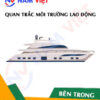
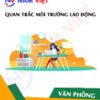
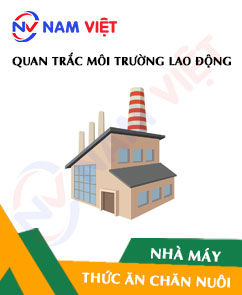
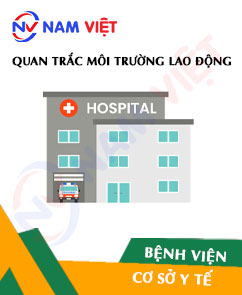

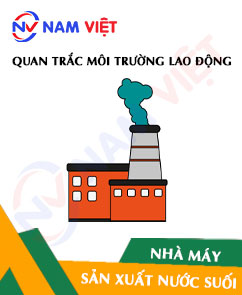
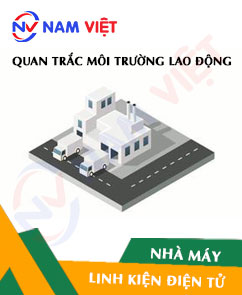



Review Occupational environment monitoring in a mine
There are no reviews yet.